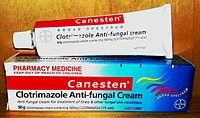
Photo from wikipedia
The search for new antifungal strategies to overcome Candida infections is essential and a matter of public health, due to the high mortality associated to candidiasis, the increasing incidence of… Click to show full abstract
The search for new antifungal strategies to overcome Candida infections is essential and a matter of public health, due to the high mortality associated to candidiasis, the increasing incidence of resistance to antifungals and the limited number of drugs available for treatment. Several approaches have been exploited in order to develop new antifungal strategies, e.g. the use of natural products, vaccines, and the combination of an antifungal drug to a non-antifungal substance. Nonetheless, issues related to pharmacokinetic parameters, toxicity and costs have been jeopardizing the discovery of new antifungal drugs. An alternative that could overcome these problems would be treating candidiasis with drugs that have been originally developed to treat other diseases. This strategy, known as drug repositioning or drug repurposing, could diminish the incidence of adverse effects and lower the cost of production, since several steps involved in drug discovery and development have already been accomplished. This review presents a set of known drugs that have been exploited as anticandidal agents, such as antidepressant agents, antiepileptic drugs, statins, among others. These substances affect the growth of Candida spp. in vitro, as well as virulence factors such as morphogenesis and biofilm formation. Moreover, some drugs are able to potentiate the anticandidal activity of known antifungal drugs. Drug repositioning appears as a remarkable alternative to increase the pharmacological arsenal against candidiasis, but further studies must be conducted in order to evaluate the real applicability of known drugs in the treatment of these infections.
Journal Title: Journal de mycologie medicale
Year Published: 2019
Link to full text (if available)
Share on Social Media: Sign Up to like & get
recommendations!